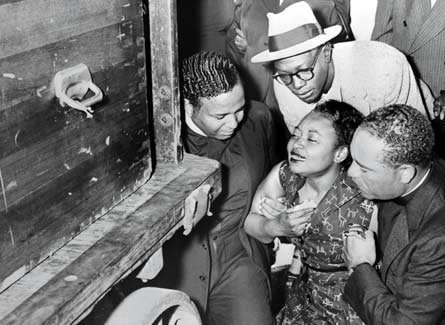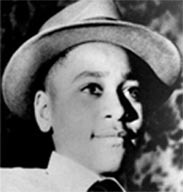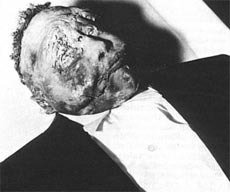Sent to you by moya via Google Reader:
she wanted the world to see what they had done to her baby, Emmett. so as we quickly approach the day Emmett was violently violated and killed (August 28), i want to consider again the religious ethics that prompted his mother's — Mamie Till-Bradley — desire for the world to experience the death of her son. of course, we already know that death is anything but uncommon. it is but a part of what we call life, it is the culmination of such lived experience and behavior. death is not unique of itself, so we must know that Till-Bradley was not celebrating the death of her son. thus when she declared that she wanted the world to see, it was not death itself, but a particular aesthetic, a specific mode of violence in which she and her son lived, that she wanted to display for the world. that is, she wanted the world to see the way folks would go about murder, the evacuative nature of such violence and the sorta havock it produced on flesh and blood. she wanted the world to see what violence does in the world, how it bloats and mottles, how it distends and reeks in order to prompt us to engage with others another way.
an active member of Evangelistic Crusaders Church of God in Christ, Mamie Till-Bradley was pentecostal and i want to consider her openness to what Anthony Heilbut describes as "the blackest of institutions," i.e., black pentecostalism, opens up for Till-Bradley in terms of a very specific enactment of black feminist care [of her son, for her community [and community is not fictitious or mythical]] and critique of the world that would allow such violence and violation to occur.
can we think with her? experience her grief? Emmett's mythic whistle turned
lynch
cotton gin
70 pounds
barb wire tied
noose neck
throw in water
sinksinksink
drowndrowndrown
clench teeth
(maybe he was dead already? but)
clinch teech
underwater, underneath
the sound, the sound of
breath stolen
life stolen
mississippi? goddamn.
1955 saw her son's demise and it took several days, and several phone calls in order for Till-Bradley to convince the municipality of Money, to return Emmett's body to chicago. and we know that the return of the body to chicago was nothing short of an attack on the senses. so much so that it is said that Emmett's body could be smelled blocks away from where it emanated. can you hear her? screaming? crying? the loss of her son.
mississippi? goddamn.
she wanted the world to see what happened to her son, so she decided to have an open casket at the funeral: "There was just no way I could describe what was in that box. No way. And I just wanted the world to see." what does this open casket and her pentecostalism have to do with each other? hers was the same sorta pentecostalism that was only gaining a bit of popularity in 1955, from which many mainline black churches — baptists, ame zions, methodists — were distancing themselves. this was the same sorta pentecostalism that was getting people kicked out of their homes for joining up with the "holy rollers" and the "sanctifieds…" in other words, this wasn't a popular sect at all, and the disdain often functioned by way of an indictment against the emotionalism, the tears, the running and shouting (not to be confused with hollering) around and in the church. and of course, these emotive bursts are not reducible to pentecostalism, though i'd argue that in a cultural worldview, pentecostalism is thought to be constituted by these seemingly excessive physical, embodied practices.

what does this religiocultural experience for Mamie Till-Bradley have to do with her desire for a radical, excessive, emotional openness? not just an openness to the horrors of the world? she was, to be sure, a black mother. and Moynihan's report was soon to come, the "pathologies" he'd happen upon were previous to that "report" (1965). black motherhood was always conceived as something of an impossibility. she was also radically open to display, to showing that was at the same time, always already more than merely showing, more than merely visual. and if we think about the song that i oft deem egotistical for a church to sing —you can't join it, you've got to be born in it-- with Till-Bradley's public display of her son in mind, one wonders what the relation of this particular kind of seeing that necessitates hearing is to being born into a movement, rather than merely joining it. that is, i do believe that the work of social justice is not about merely declaring yourself a part of it. but it takes a transformative posture, an ennobling force, some state of ultimate concern that evacuates a sense of individualism and joins one to community to struggle together.
she wanted the world to experience what had been done. the dismemberment, the disfigurement. this was, in my estimation, a public theology of pentecostalism that became an important moment in the long history and tradition of black social upheaval. to be sure, Emmett was not the first to be lynched and would not be the last. but his moment served as a hinge of sorts. Brown v. Board of Education took place one year previous but schools would not be desegregated until at least 1957 with the Little Rock 9. i'd argue that Mamie Till-Bradley's religiocultural, existential crisis that was bound up with an embodied religious experience is what made a movement that was already moving move further still. that is, though movement for civil rights were underway before the picture of swollen, mottled body was circulated, that the desire for the world to see reverberated and echoed. it made pentecostalism public, palpable, pleasurable. it gave pentecostalism what it already had: the capacity to be transformative, to enact social justice. but more, she gave the movement for civil rights an aesthetics that it already had. pentecostal theology is about the emptying out of oneself in order to be filled with the Divine. and this emptied fulfilling is noticed by way of movement, sound, dance, by the way one behaves and comports. an aesthetic of excess is normative. but the display of the image of her son was also about knowing that brutality does not take away the capacity to be filled and moved. she should have been so hurt because of her son's death that immobility would have been understandable. but the capacity to move remained. through it all…
of course, Till-Bradley was not happy. she was not happy to have lost a son. she was not happy to open a casket and have the world see. but she did it anyway. the old saints would call it "holy boldness." they'd say that in the face of the incalculable, regardless of the rejection from friends and family, that there was something down inside them telling them to go on ahead. to keep moving forward. i feel constrained to say i love this narrow way, glory hallelujah, i'm one of them today.


Till-Bradley knew something of a holy defiance that was not about happiness but that echoed pleasure. of course, she loved her son. she enjoyed her time with her son. she wanted the best for him. her display of his open face, by way of an open casket, was her giving the world the gift of her capacity to love. she could not describe her love, so she gave something else: she gave the edge, the bruise, the image of what took him away. she gave us the moment of her most ineffable and pointed coalescence of emotion. the fact that she could not describe is not surprising. so indescribable, words don't go there, so maybe moaning will. to give the world the image of her inability talk, to enunciate, to describe, to give the image of a moan? it is to make visual the sound of moaning (and what i'm saying here, of course, is not new).
certainly, her love was not reducible to the photograph, or the image, or her tears. but in those moments that we see of her, and in his stillness, his swollen body that she gave us to see? therein we see the love of black mothers that Moynihan thought impossible.
what if we thought of excess as prompting thought? Till-Bradley wanted us to see these images. there is within them, i think, the energy of her love. there is within them, i think, the energy of her theological, existential position…a peculiar people, indeed. something is internal to the image of Emmett that is also internal to Mamie Till-Bradley's religious posture, a quickening and movement of the spirit, by the spirit towards justice. so, and of course, as we approach the day of Emmett's death, the day when the love of Till-Bradley turned into a force of movement, we can not simply shed tears of a bygone time. James Craig Anderson's recent death — in mississippi, goddamn — rehearses for us the ongoingness of racial animosity, hate and fear. times are still very urgent and i think Till-Bradley's black feminist aesthetics of openness and movement still echo with us today, and still have the capacity to inform our resistance against these institutional and systemic forces that refresh and revise racism for a new era.
Things you can do from here:
- Subscribe to The Crunk Feminist Collective using Google Reader
- Get started using Google Reader to easily keep up with all your favorite sites
.jpg)
No comments:
Post a Comment